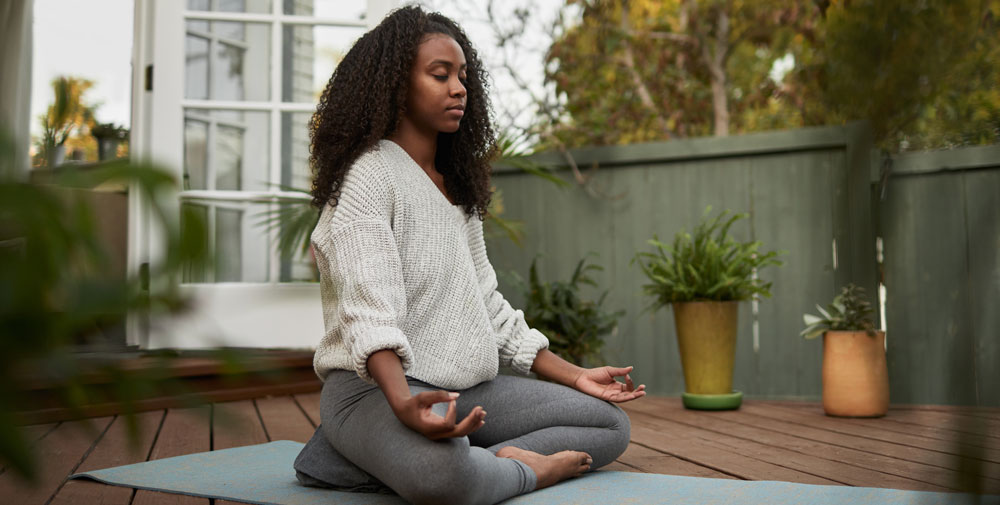Research shows that different emotions are associated with different forms of breathing. When you feel joy, your breathing will be regular, deep, and slow. On the other hand, if you feel anxious or angry, your breathing will be irregular, short, fast, and shallow.
Triggering your parasympathetic nervous system through breathwork can help you calm down, resulting in you starting to feel better. Your ability to think rationally will return, as well. In fact, research has shown that mindful breathing exercises, especially deep breathing techniques, can improve your mood and reduce stress.
So, if you feel your mind starting to spiral out of control and notice that your breathing is short and fast, try one of these easy breathing exercises to calm your body and mind.
Breath Awareness: A yoga breathing technique, breath awareness revolves around becoming aware of your breath. All you have to do is focus your attention on your inhales and exhales. Simply bringing attention to your breathing patterns and noticing what is happening with your breath is sometimes enough to create a major shift.
Calming Breath: When you inhale, your heart rate speeds up. When you exhale, it slows down. So, breathing in for a count of four and out for a count of eight for even just a few minutes can start to calm your nervous system. To train your body to breathe better, use the Calming Breath method to reduce daily stress. You can practice the Calming Breath method either while sitting upright or standing. Start by straightening your posture. Then begin with a long, slow breath through your nose, first filling your lower lungs, and then your upper lungs. Place a hand on your belly to feel it expand. Next, hold your breath to the count of three. Then exhale slowly through your mouth, making sure that you relax your body, especially your face, neck, shoulders, and torso. Try doing the Calming Breath method for five minutes every day, or whenever you want to calm yourself down.
Belly Breathing (Or Diaphragmatic Breathing): Belly breathing, or diaphragmatic breathing, is a basic breathing technique that is easy to do and can be done anytime you need to relax or want to relieve stress. In addition to reducing stress and anxiety, belly breathing also offers additional benefits for your body and mind such as lowering your blood pressure, lowering your heart rate, boosting your metabolism, and strengthening your diaphragm. To practice belly breathing, sit or lie flat in a comfortable position. Place one hand on your belly (just below your ribs) and your other hand on your chest. Take a deep breath in through your nose, and let your belly push your hand out. Your chest shouldn’t move. Then breathe out through pursed lips as if you were whistling. Feel the hand on your belly go in, and use it to push all of the air out. Do this three to five times and take your time with each breath.
Morning Breathing: To relieve muscle stiffness and clear clogged breathing passages, try morning breathing when you first get up. From a standing position, bend forward from your waist with your knees slightly bent, letting your arms dangle close to the floor. As you inhale slowly and deeply, return to a standing position by rolling up slowly, while making sure to lift your head last. Hold your breath for just a few seconds in this standing position before exhaling slowly as you return to the original position, bending forward from your waist. You can also do morning breathing throughout the day to relieve back tension.
Lion’s Breath: A type of yogic breathing, lion’s breath is said to alleviate stress, and stimulate your throat and upper chest. To do lion’s breath, begin in a comfortable seated position. Lean forward slightly, while bracing your hands on your knees (or on the floor). Spread your fingers as wide as possible, inhale through your nose, and open your mouth wide. Then stick your tongue out and stretch it down toward your chin. Exhale forcefully, and make a ‘ha’ sound that comes from deep within your abdomen while exhaling. Breathe normally for a few moments and then repeat the lion’s breath up to seven times. Finish by breathing deeply for one to three minutes.
Easy Breathing Exercises For Anxiety (And A Good Night’s Sleep!)
Alternate Nostril Breathing: Alternate nostril breathing is an easy breathing technique that can stimulate mindful, sleep-inducing breathing since this technique balances both hemispheres of your brain, while telling the chatter in your brain to calm down at the same time. To add alternate nostril breathing to your bedtime relaxation routine, start by sitting up on the edge of your bed. With the palm of your right hand facing you, fold down your pointer and middle finger, while keeping your other fingers extended. Then close your right nostril with your right thumb and inhale slowly and gently through your left nostril. Lightly close your left nostril with your ring finger and little finger so that both of your nostrils are held closed for a brief pause. Open your right nostril and exhale slowly through the right. Then inhale slowly on the same side. Gently close your right nostril with your right thumb, and pause for a brief moment as you hold both of your nostrils closed again. Open your left nostril and exhale slowly. Then inhale slowly on the same side. Repeat this cycle a few times before you go to sleep.
4-7-8 Breathing or Relaxing Breath: The 4-7-8 breathing technique, which is also known as relaxing breath, is a breathing pattern that aims to reduce anxiety or help people get to sleep, with some proponents claiming that this method helps people get to sleep in one minute. To practice the 4-7-8 breathing technique, begin by emptying your lungs of air. Then breathe in quietly through your nose for four seconds. Hold your breath for a count of seven seconds and then exhale forcefully through your mouth, pursing your lips and making a ‘whoosh’ sound for eight seconds. Repeat this cycle up to four times.
One-To-Two Ratio Breathing: One-to-two ratio breathing is also recommended for sleep since the goal of this breathwork exercise is to help put the swirling thoughts in your mind to rest so that you can get a good night’s sleep. Simply inhale for three counts, then exhale for six counts. Try to transition seamlessly between the two so that your breath is continuous. Repeat for five minutes.
Breathing Technique For Mastering A Deeper And Better Breath
Roll Breathing helps you develop full use of your lungs and to focus on the rhythm of your breathing. While you can do roll breathing in any position, it’s best to lie on your back with your knees bent when you’re first learning how to do it.
To practice roll breathing, place your left hand on your belly and your right hand on your chest, noticing how your hands move as you breathe in and out. Practice filling your lower lungs by breathing so that your ‘belly hand’ (left hand) goes up when you inhale and your ‘chest hand’ (right hand) remains still. Always breathe in through your nose and breathe out through your mouth. Do this eight to 10 times.
When you have filled and emptied your lower lungs eight to 10 times, add the second step to your breathing, which is inhaling first into your lower lungs as before, and then continue inhaling into your upper chest. Breathe slowly and regularly. As you do this, your right hand will rise and your left hand will fall a little as your belly falls. As you exhale slowly through your mouth, make a quiet, whooshing sound as first your left hand and then your right hand fall. As you exhale, feel the tension leaving your body as you become more relaxed. Practice breathing in and out this way for three to five minutes.
It’s important to note that some people do get dizzy the first few times that they try roll breathing. So, if you begin to breathe too fast or feel lightheaded, slow your breathing. Make sure that you get up slowly, as well.
*The links used in this article are being provided as a convenience and for informational purposes only; they do not constitute an endorsement or an approval by Iovate Health Sciences International Inc. or any of its affiliates (“Iovate”) of any of the products, services or opinions of the corporation or organization or individual. Iovate bears no responsibility for the accuracy, legality or content of the external site or for that of subsequent links. Contact the external site for answers to questions regarding its content.







